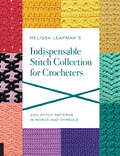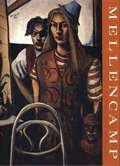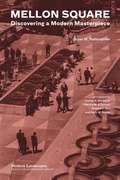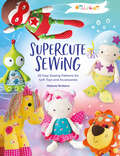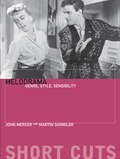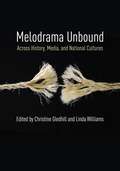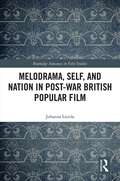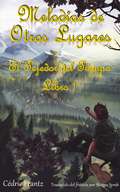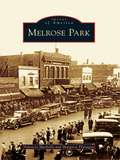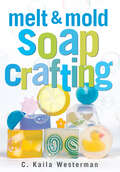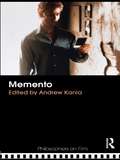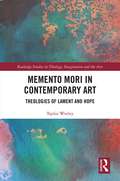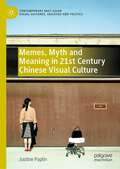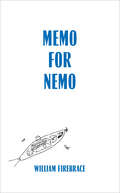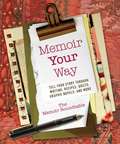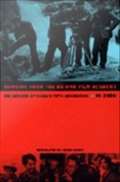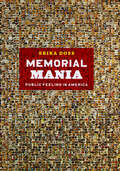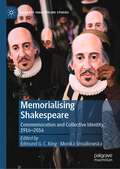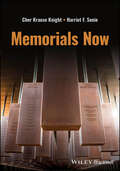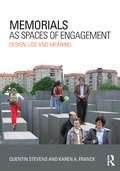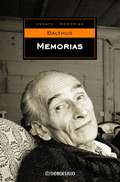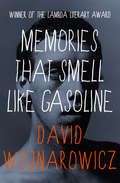- Table View
- List View
Melissa Leapman's Indispensable Stitch Collection for Crocheters: 200 Stitch Patterns in Words and Symbols
by Melissa LeapmanThe crochet diva divulges two hundred of her favorite crochet stitch patterns—including many original designs—to keep you busy stitching for years!With many original designs and others garnered from Melissa Leapman’s years of experience in the industry, this book is geared toward crocheters of all levels and formatted in a way that encourages learning and skill-building.The beginning features a pattern library with a full explanation of stitch multiples and how they work. Suggestions are offered about how to design basic projects, including afghans, pillows, hats, and more. The book’s second section offers stitch patterns arranged by type—from lace to cables to colorwork and beyond. Each stitch pattern is accompanied by easy-to-read instructions, stitch diagrams using international symbols, and a clear photo. If the reverse side of the fabric is interesting for a given pattern, both sides will be presented. A unique icon is used to mark these special patterns, making them easy to seek out for versatile scarves and blankets, which must look attractive on both sides. With these patterns that just beg to be stitched, you’ll be making hats, scarves, shawls and more for yourself, family, and friends.“Leapman’s experience paired with the readability of this book makes it a great addition to any crochet library.” —Jessica Carpender, editor, FaveCrafts.com
Mellencamp
by John MellencampJohn Mellencamp is one if the true Renaissance men of popular music. In the public spotlight for over twenty-five years, with a string of number one hits and multiplatinum records side to his artistic talent that is celebrated in the full-color selection of evocation paintings. Mellencamp began pursuing oil painting in 1988 as a means of further artistic exploration. His first subjects were friends, family, and landscapes reminiscent of the French impressionists, which have since evolved into a personal style of portraiture.Critics have drawn parallels between Mellencamp's work and the dark, shadowy paintings of the German expressionists. Mellencamp believes in art as a means of self-exploration and as an incentive to make people more curious about the world. He has exhibited extensively in the Midwest and the South, and most of his paintings have been purchased for private collections. With seventy-five full-color representations if the artist's favorite paintings, twenty-five black-and-white photographs taken from his personal collection, and an introduction by Billboard magazine's editor-in-chief, Timothy White, Mellencamp: Paintings and Reflections is the perfect gift for any Mellencamp fan or anyone who appreciates fine art. --This text refers to an out of print or unavailable edition of this title.
Mellon Square
by Susan Rademacher Charles BirnbaumThe second volume in our Modern Landscapes series examines the evolution of Pittsburgh's first modern garden plaza. Completed in 1955 from a design by the acclaimed landscape design firm Simonds & Simonds and architects Mitchell & Ritchey, Mellon Square functioned as an urban oasis that provided downtown office workers a much-needed respite from the city's infamous smoke pollution. Now, more than six decades later, Mellon Square is undergoing a major restoration by Patricia O'Donnell of Heritage Landscapes that aims to restore this urban garden and help revitalize downtown Pittsburgh. Featuring new photography and archival material, Mellon Square is the only book to showcase the development of this iconic urban landscape.
Melly & Me: 20 Easy Sewing Patterns for Soft Toys and Accessories
by Melanie McNeiceDiscover a colourful world of adorable animals and fantastical creatures in this fun collection of sewn toys and gifts, brought together into one volume for the first time. Children and adults will adore this collection of cute and quirky stuffed toys and home accessories by leading soft toy designer, Melly McNeice. There are a total of twenty projects to choose from so there is something for everyone. Pick your favourite from a pretty butterfly mobile for a new arrival, a cuddly spaceship for a curious kid or a handy ladybug bag for a little fashionista - there's something to delight kids of all ages! The stuffed toy sewing patterns that are featured in this collection include friendly monsters, affable aliens magical mermaids, circus lions, pretty unicorns and much, much more. This selection of 'huggable' creatures from Melly McNeice will capture your imagination as much as your child's. Each of the animals and creatures featured in this selection has their own personality, and they are perfectly proportioned for little hands to hold. They also make the perfect prompts for story telling or a bedtime tale. Maybe your little one dreams of transforming into a high-spirited princess or a flying superhero? As well as the toys there are projects to brighten up the nursery: choose from a butterfly mobile, a wonderfully colourful, applique floral quilt, and a ladybird bird backpack for fun days out. These simple patterns will have you sewing toys and gifts in no time. Each of the twenty brightly coloured projects is suitable for sewers of all abilities and comes with easy-to-follow step-by-step instructions and full-size templates so you can start sewing straight away. Melly recommends reading through all the patterns before starting a project to decide whether it's a quick and easy make which is perfect for last minute gifting or a longer project which will help you to build your toy making skills. Enjoy making your super cute toys and gifts and we hope that the resulting toys will bring the special little people in your life many hours of imagination-filled play, memorable moments and comforting cuddles.
Melodrama
by Martin Shingler John MercerMelodrama: Genre, Style and Sensibility is designed as an accessible overview of one of the most popular genres at undergraduate Film Studies. The book identifies three distinct but connected concepts through which it is possible to make sense of melodrama; either as a genre, originating in European theatre of the 18th and 19th century, as a specific cinematic style, epitomised by the work of Douglas Sirk or as a sensibility that emerges in the context of specific texts, speaking to and reflecting the desires, concerns and anxieties of audiences. Films discussed include All That Heaven Allows, Safe, Fear Eats the Soul, Black Narcissus, Suddenly Last Summer and Rebel Without a Cause. Each chapter includes overviews of key essays, analyses of significant and widely studied films and includes an annotated reading list.
Melodrama Unbound: Across History, Media, and National Cultures (Film and Culture Series)
by Linda Williams Christine GledhillFor too long melodrama has been associated with outdated and morally simplistic stereotypes of the Victorian stage; for too long film studies has construed it as a singular domestic genre of familial and emotional crises, either subversively excessive or narrowly focused on the dilemmas of women. Drawing on new scholarship in transnational theatrical, film, and cultural histories, this collection demonstrates that melodrama is a transgeneric mode that has long spoken to fundamental aspects of modern life and feeling.Pointing to melodrama’s roots in the ancient Greek combination of melos and drama, and to medieval Christian iconography focused on the pathos of Christ as suffering human body, the volume highlights the importance to modernity of melodrama as a mode of emotional dramaturgy, the social and aesthetic conditions for which emerged long before the French Revolution. Contributors articulate new ways of thinking about melodrama that underscore its pervasiveness across national cultures and in a variety of genres. They examine how melodrama has traveled to and been transformed in India, China, Japan, and South America, whether through colonial circuits or later, globalization; how melodrama mixes with other modes such as romance, comedy, and realism; and finally how melodrama has modernized the dramatic functions of gender, class, and race by orchestrating vital aesthetic and emotional experiences for diverse audiences.
Melodrama, Self and Nation in Post-War British Popular Film (Routledge Advances in Film Studies)
by Johanna LaitilaThis book investigates the portrayal of nationalities and sexualities in British post-Second World War crime film and melodrama. By focussing on these genres, and looking at the concept of melodrama as an analytical tool apt for the analysis of both sexuality and nation, the book offers insight into the desires, fears, and anxieties of post-war culture. The problem of returning to ‘normalcy’ after the war is one of the recurring themes discussed; alienation from society, family, and the self were central issues for both women and men in the post-war years, and the book examines the anxieties surrounding these social changes in the films of the period. In particular, it explores heterosexuality and nationality as some of the most prominent frameworks for the construction of identities in our time, structures that, for all their centrality, are made invisible in our culture.
Melodrama: Genre, Style and Sensibility (Short Cuts)
by Martin Shingler John MercerMelodrama: Genre, Style and Sensibility is designed as an accessible overview of one of the most popular genres at undergraduate Film Studies. The book identifies three distinct but connected concepts through which it is possible to make sense of melodrama; either as a genre, originating in European theatre of the 18th and 19th century, as a specific cinematic style, epitomised by the work of Douglas Sirk or as a sensibility that emerges in the context of specific texts, speaking to and reflecting the desires, concerns and anxieties of audiences. Films discussed include All That Heaven Allows, Safe, Fear Eats the Soul, Black Narcissus, Suddenly Last Summer and Rebel Without a Cause. Each chapter includes overviews of key essays, analyses of significant and widely studied films and includes an annotated reading list.
Melodías de otros lugares: El tejedor del tiempo - Libro 1
by Cédric FrantzEl equinoccio de primavera se acerca y el invierno está llegando a su fin en Jantival. Kalaen, de once años, lleva una vida ejemplar en su casa familiar. Apasionado por la ciencia y la música, descubre talentos innatos: tiene una percepción inusual del mundo que le rodea. Sus dones extrasensoriales incluso lograron impresionar a su vecino, el anciano alquimista y mago Falchron. Kalaen le tiene un respeto especial y secretamente desea seguir sus pasos. Durante una expedición en el bosque, hace un encuentro inusual y trae a la aldea un objeto misterioso. Con Falchron, intentan entonces desvelar los secretos de esta reliquia que parece datar de tiempos inmemoriales. ¿Cuál es la función de este extraño artefacto? ¿Lograrán descubrirlo? ¿Descubrirán las memorias del tiempo o escucharán el presagio de su fin?
Melrose Park
by Fidencio Marbella Margaret FlanaganOriginally founded by German immigrants, followed by successive waves of Lithuanians, Italians, and Hispanics, Melrose Park has undergone a series of transformations since its incorporation in 1882. Close proximity to Chicago and the coming of the Chicago and Northwestern Railroad ensured that Melrose Park became a center for manufacturing and heavy industry. Major companies including Benjamin Moore, International Harvester, and the National Malleable Castings Company built plants here, and the town was also known as the headquarters for Polk Brothers. Entertainment and leisure activities have been an important part of life in Melrose Park too. Kiddieland Amusement Park was built in 1929, quickly becoming a popular destination for Chicago area families, and the town was also home to classic movie theaters, the North Avenue Rollerway, and the Come Back Inn, a popular local restaurant. The Feast of Our Lady of Mount Carmel is a cherished Melrose Park event that has been celebrated annually since 1894.
Melt & Mold Soap Crafting
by C. Kaila WestermanCook colorful, whimsical, eye-catching soaps right in your microwave! It’s easy and fun with C. Kaila Westerman’s guide to creative soap making. Westerman’s recipes are free of harsh chemicals and she encourages you to play with colors, scents, and shapes that the whole family will enjoy — from rubber duckies to sailboats, stars, and gemstones. With an inexpensive soap base, some food coloring, and a bit of imagination, you can quickly create handy bars for kid-friendly cleaning and hours of bath time fun.
Melting Away
by Camille SeamanFor ten years Camille Seaman has documented the rapidly changing landscapes of Earth's polar regions. As an expedition photographer aboard small ships in the Arctic and Antarctic, she has chronicled the accelerating effects of global warming on the jagged face of nearly fifty thousand icebergs. Seaman's unique perspective of the landscape is entwined with her Native American upbringing: she sees no two icebergs as alike; each responds to its environment uniquely, almost as if they were living beings. Through Seaman's lens, each towering chunk of ice--breathtakingly beautiful in layers of smoky gray and turquoise blue--takes on a distinct personality, giving her work the feel of majestic portraiture. Melting Away collects seventy-five of Seaman's most captivating photographs, lifeaffirming images that reveal not only what we have already lost, but more importantly what we still have that is worth fighting to save.
Memento (Philosophers on Film)
by Andrew KaniaWithin a short space of time, the film Memento has already been hailed as a modern classic. Memorably narrated in reverse, from the perspective of Leonard Shelby, the film’s central character, it follows Leonard’s chaotic and visceral quest to discover the identity of his wife’s killer and avenge her murder, despite his inability to form new long-term memories. This is the first book to explore and address the myriad philosophical questions raised by the film, concerning personal identity, free will, memory, knowledge, and action. It also explores problems in aesthetics raised by the film through its narrative structure, ontology, and genre. Beginning with a helpful introduction that places the film in context and maps out its complex structure, specially commissioned chapters examine the following topics: memory, emotion, and self-consciousness agency, free will, and responsibility personal identity narrative and popular cinema the film genre of neo-noir Memento and multimedia Including annotated further reading at the end of each chapter, Memento is essential reading for students interested in philosophy and film studies.
Memento Mori in Contemporary Art: Theologies of Lament and Hope (Routledge Studies in Theology, Imagination and the Arts)
by Taylor WorleyThis book explores how four contemporary artists—Francis Bacon, Joseph Beuys, Robert Gober, and Damien Hirst—pursue the question of death through their fraught appropriations of Christian imagery. Each artist is shown to not only pose provocative theological questions, but also to question the abilities of theological speech to adequately address current attitudes to death. When set within a broader theological context around the thought of death, Bacon’s works invite fresh readings of the New Testament’s narration of the betrayal of Christ, and Beuys’ works can be appreciated for the ways they evoke Resurrection to envision possible futures for Germany in the aftermath of war. Gober’s immaculate sculptures and installations serve to create alternative religious environments, and these places are both evocative of his Roman Catholic upbringing and virtually haunted by the ghosts of his excommunication from that past. Lastly and perhaps most problematically, Hirst has built his brand as an artist from making jokes about death. By opening fresh arenas of dialogue and meaning-making in our society and culture today, the rich humanity of these artworks promises both renewed depths of meaning regarding our exit from this world as well as how we might live well within it for the time that we have. As such, it will be a vital resource for all scholars in Theology, the Visual Arts, Material Religion and Religious Studies.
Memes, Myth and Meaning in 21st Century Chinese Visual Culture (Contemporary East Asian Visual Cultures, Societies and Politics)
by Justine PoplinThis book explores the impact of global change in China in what is considered in the West as ‘the Asian century’ and what this in turn means for visual culture. Unravelling a deep understanding of historical shifts in visual culture that represent socio-political mirrors of culture, it expands the Western perception of Chinese visual culture and the intertwined complexities of cultural signification. This book provides a key resource for Galleries and Academic Institutions, offering insights into understanding the systems underpinning ideas, skills and influences of the new visual culture in the Asian century.
Memo for Nemo
by William FirebraceA cultural history of living in the undersea, both fictional and real, from Jules Verne&’s Captain Nemo to NASA&’s ECC02 project.In Memo for Nemo, William Firebrace investigates human inhabitation of the undersea, both fictional and real. Beginning with Jules Verne&’s Captain Nemo—an undersea Renaissance man with a library of 12,000 volumes on his submarine—and proceeding through aquariums, undersea photography, artificial seas on land, nuclear-powered submarines, undersea film epics, giant squid, and NASA satellites, Firebrace examines the undersea as a zone created by exploration and invention. Throughout, the history of undersea life is accompanied by an imagined undersea, envisioned by cultural figures ranging from Verne and Herman Melville to Orson Welles and Jimi Hendrix. Firebrace takes readers though the enormous sequence of rooms (impossible in real life) in Nemo&’s submarine, recounts the competition among nineteenth-century cities to build the most spectacular aquatic world, and explains the workings of the bathysphere—an early underwater vessel modeled on a hot-air balloon. He considers the aquarium&’s function in films as a sort of viewing lens, describes the chlorine-proof artificial sea life seen by passengers on the submarine ride at Disneyland, and reports that Jacques Cousteau&’s famous underwater documentaries were in fact highly staged. The oceans of today are not those imagined by Verne; they are changing from both natural processes and human influence. Memo for Nemo documents the power of the undersea in both art and life.
Memoir Your Way: Tell Your Story through Writing, Recipes, Quilts, Graphic Novels, and More
by The Memoir RoundtableA new approach to family and personal memoirs that includes many creative formats.Memoir Your Way inspires family storykeepers to create a memoir using a craft you already know or are inspired to learn to create a personal, polished memoir your family will treasure. Accessible and with broad appeal, this first-of-its-kind book extends the written memoir form to cookbooks, scrapbooks, quilts, and other forms of storytelling.Readers of Memoir Your Way will find out how to:Create your own family cookbook like a proDesign, stitch, and create stunning quilts that preserve family memories for the next generation and create a cherished giftBring out the natural storyteller in children while building self-confidence and a sense of familyWrite engaging family stories with proven writing tipsEnrich scrapbooks with stories that might otherwise be overlooked and techniques that showcase even the memories that weren't preserved in photographsTurn your story into a graphic novel with hand-drawn illustrationsBecome the bridge for your heritage between the old world and the newMemoir Your Way makes memoir accessible to everyone, including those who don't see themselves as writers. Memoir Your Way is a valuable sourcebook for quickly and easily creating memoirs that celebrate family stories and ancestry.
Memoirs from the Beijing Film Academy: The Genesis of China's Fifth Generation
by Ni ZhenAfter graduating from the Beijing Film Academy in 1982, directors like Chen Kaige and Zhang Yimou transformed Chinese cinema with Farewell My Concubine, Yellow Earth, Raise the Red Lantern, and other international successes. Memoirs from the Beijing Film Academy tells the riveting story of this class of 1982, China's famous "Fifth Generation" of filmmakers. It is the first insider's account of this renowned cohort to appear in English. Covering these directors' formative experiences during China's tumultuous Cultural Revolution and later at the Beijing Film Academy, Ni Zhen--who was both their screenwriter and teacher--provides unique insights into the origins of the Fifth Generation's creativity. Drawing on his personal knowledge and interviews conducted especially for this volume, Ni Zhen demonstrates the diversity of the Fifth Generation. He comments on the breadth of styles and themes explored by its members and introduces a range of male and female directors, cinematographers, and production designers famous in China but less well-known internationally. The book contains vivid descriptions of the production processes of two pioneering films--One and Eight and Yellow Earth.
Memorial Mania: Public Feeling in America
by Erika DossIn the past few decades, thousands of new memorials to executed witches, victims of terrorism, and dead astronauts, along with those that pay tribute to civil rights, organ donors, and the end of Communism have dotted the American landscape. Equally ubiquitous, though until now less the subject of serious inquiry, are temporary memorials: spontaneous offerings of flowers and candles that materialize at sites of tragic and traumatic death. In Memorial Mania, Erika Doss argues that these memorials underscore our obsession with issues of memory and history, and the urgent desire to express—and claim—those issues in visibly public contexts.Doss shows how this desire to memorialize the past disposes itself to individual anniversaries and personal grievances, to stories of tragedy and trauma, and to the social and political agendas of diverse numbers of Americans. By offering a framework for understanding these sites, Doss engages the larger issues behind our culture of commemoration. Driven by heated struggles over identity and the politics of representation, Memorial Mania is a testament to the fevered pitch of public feelings in America today.
Memorialising Shakespeare: Commemoration and Collective Identity, 1916–2016 (Palgrave Shakespeare Studies)
by Edmund G. C. King Monika SmialkowskaThis book is the first comprehensive account of global Shakespeare commemoration in the period between 1916 and 2016. Combining historical analysis with insights into current practice, Memorialising Shakespeare covers Shakespeare commemoration in China, Ukraine, Egypt, and France, as well as Great Britain and the United States. Chapter authors discuss a broad range of commemorative activities—from pageants, dance, dramatic performances, and sculpture, to conferences, exhibitions, and more private acts of engagement, such as reading and diary writing. Themes covered include Shakespeare’s role in the formation of cultural memory and national and global identities, as well as Shakespeare’s relationship to decolonisation and race. A significant feature of the book is the inclusion of chapters from organisers of recent Shakespeare commemoration events, reflecting on their own practice. Together, the chapters in Memorialising Shakespeare show what has been at stake when communities, identity groups, and institutions have come together to commemorate Shakespeare.
Memorials Now
by Cher Krause Knight Harriet F. SenieA comprehensive guide to addressing the present-day challenges of commemorating the past As debates over historical monuments and their meanings unfold, Memorials Now offers a critical exploration of how communities can navigate the complex terrain of commemorative practices. From controversial statues to emerging forms of public memory, the topics covered in this timely volume provide insights into historical challenges while also encouraging a more inclusive and just memorial landscape for the future. Authors Cher Krause Knight and Harriet F. Senie explore evolving narratives of heroes and victims, ethical challenges of memorial design, strategies for promoting inclusivity, and possibilities for alternative forms of commemoration. Memorials Now analyzes case studies from around the world in which communities are rethinking their memorials and creating innovative memorialization projects that reflect shifting cultural values. Memorials Now is ideal for students and educators in art history, architecture, urban planning, and cultural studies, as well as professionals in fields such as public art, city planning, museum curation, and civic engagement.
Memorials as Spaces of Engagement: Design, Use and Meaning
by Karen A. Franck Quentin StevensMemorials are more diverse in design and subject matter than ever before. No longer limited to statues of heroes placed high on pedestals, contemporary memorials engage visitors in new, often surprising ways, contributing to the liveliness of public space. In Memorials as Spaces of Engagement Quentin Stevens and Karen A. Franck explore how changes in memorial design and use have helped forge closer, richer relationships between commemorative sites and their visitors. The authors combine first hand analysis of key examples with material drawn from existing scholarship. Examples from the US, Canada, Australia and Europe include official, formally designed memorials and informal ones, those created by the public without official sanction. Memorials as Spaces of Engagement discusses important issues for the design, management and planning of memorials and public space in general. The book is organized around three topics: how the physical design of memorial objects and spaces has evolved since the 19th century; how people experience and understand memorials through the activities of commemorating, occupying and interpreting; and the issues memorials raise for management and planning. Memorials as Spaces of Engagement will be of interest to architects, landscape architects and artists; historians of art, architecture and culture; urban sociologists and geographers; planners, policymakers and memorial sponsors; and all those concerned with the design and use of public space.
Memorias
by Balthus«La vida ha sido para mí una larga tarea de la que no me arrepiento en absoluto», comenta Balthus en una de las páginas de este magnífico libro de memorias, y esas son quizá las palabras que mejor resumen la trayectoria vital de un hombre consagrado a la pintura con el mismo afán y la misma humildad con que otros se entregan a la religión. Convencido desde muy joven de su condición de artesano y poco dispuesto a dejarse llevar por los reclamos de la vanguardia, Balthus se dedicó a estudiar a los grandes maestros, intentando penetrar los matices de esa luz tan peculiar que desprenden las telas de Masaccio, de Piero della Francesca y Giotto. Ahí, en la atenta contemplación de los primitivos italianos, el joven pintor pudo tejer un hilo que une Oriente con Occidente, y a Fra Angélico con Poussin y Cézanne, hasta llegar a nuestros días. Amigo personal de Modigliani y Picasso, instalado desde hacía muchos años en la mansión de Rossinière, Balthus dictó estas memorias cuando su vida ya se acababa, hablando por fin del auténtico significado de algunos de sus cuadros y de la búsqueda incansable, desesperada a veces, de una perfección que iba más allá de la técnica para instalarse en la ética. Hombre modesto y esquivo, Balthus, que solo habló cuando dejó de utilizar el pincel, nos ha dejado unas páginas hermosas donde se guarda la esencia de un arte que es oficio y es vocación.
Memories Of The Revolution: The First Ten Years Of The Wow Café Theater
by Jill Dolan Holly Hughes Carmelita TropicanaThe women's experimental theater space called the WOW Café (Women's One World) has been a vital part of New York's downtown theater scene since 1980. Since that time, WOW has provided a place for feminist and particularly lesbian theater artists to create, perform, and witness a cultural revolution. Its renowned alumnae include playwright and actor Lisa Kron, performance artists Holly Hughes and Carmelita Tropicana, the theater troupe the Five Lesbian Brothers, and actors/playwrights Peggy Shaw, Lois Weaver, and Deb Margolin, among others. Memories of the Revolution collects scripts, interviews, and commentary to trace the riotous first decade of WOW. While the histories of other experimental theater collectives have been well documented, WOW's history has only begun to be told. The anthology also includes photographs of and reminiscences by Café veterans, capturing the history and artistic flowering of the first ten years of this countercultural haven.
Memories That Smell Like Gasoline
by David WojnarowiczAutobiographical stories and drawings by the artist and AIDS activist featured in the new documentary by Chris McKim. For most of his life, David Wojnarowicz considered himself the ultimate outsider and a true invisible man. &“I&’m a blank spot in a hectic civilization,&” he writes in this fierce and unforgettable collection of four blistering autobiographical pieces, illustrated with his own arresting ink drawings. Wojnarowicz, who died of AIDS in New York City at the age of thirty-seven, left behind a body of work that was staggering in its variety and originality. Painter, writer, photographer, performance artist, and filmmaker, he made an indelible mark on virtually every stage of the national arts scene. Yet nowhere does his anger, love, or compassion show itself as strongly as in his writing, which earned a Lambda Literary Award and prompted critics to call him the Jack Kerouac of his generation. The horrors of Wojnarowicz&’s past inform his literature—his years spent as a child prostitute and living homeless on the New York streets, his outspoken, very public battle against the disease that would eventually take his life, and the entrenched government bureaucracy that sat by and did nothing. The world as seen through Wojnarowicz&’s eyes in these four masterful short works is stark, cruel, and cold—and yet gloriously alive, ennobled by surprising acts of heartrending humanity. Memories That Smell Like Gasoline is a celebration of sorts: of sex, of love, of art, and of having truly lived.
